Stalk rots are present to some extent every year. Identifying the type of stalk rot is easier during early stages of development, becoming more difficult late in the season when multiple stalk rots can affect the same plant. Regardless of which stalk rot pathogen causes the primary infection, the result is the same: yield loss due to lodging or premature plant death. Identifying stalk rots before they cause harvest losses can help prioritize harvest order.
1. Lodging – Plants infected with stalk rot pathogens are susceptible to lodging which can cause a lot of harvest loss. Leaving plants to field dry increases the risk of severe stalk lodging. Fields with a large amount of stalk rot should be harvested as soon as possible.
2. Premature Plant Death – The amount of yield loss from premature plant death depends on when plants die in relation to the stage of kernel development as shown in Table 1.
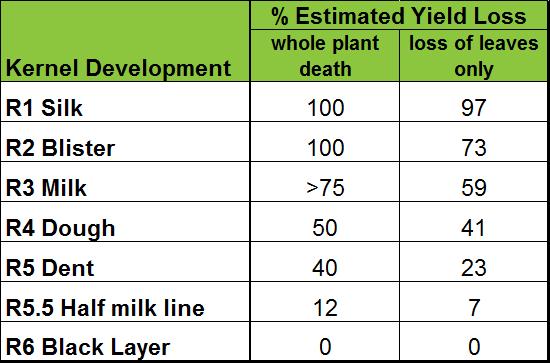
As with any disease, severity of stalk rots depends on:
1. The amount of inoculum present — Inoculum occurs naturally in the soil and on plant residue. Stalk rot inoculum is greatest with reduced tillage or corn on corn fields.
2. Susceptible host — Corn hybrids vary in susceptibility to certain types of stalk rot pathogens, but no hybrid is resistant to all stalk rots.
3. Environmental conditions — Weather largely influences which stalk rots are most prevalent each year. Root systems compromised from wet conditions at planting are more susceptible to stalk rots later in the season. Dry weather during and after pollination causes plants to remobilize sugars from stalk tissue in a process called cannibalization. Cannibalized stalks are prone to stalk rot development. Excessive rains during late grainfill depletes soil oxygen levels and causes roots to die prematurely, allowing stalk rots to move in.
PREVENTION
The best way to hold off stalk rots is to maintain healthy leaf, root, and stalk tissue late into the season. Anything that interferes with plant health and photosynthesis during grain fill will cause the plant to cannibalize stalk tissue to meet needs of the developing ear.
Stalk Inspection
Inspecting stalk integrity can be done any time. If the stalk and leaves are still green, then dig up the plant and carefully split the stalk lengthwise down through the crown. Look for discolored tissue. Healthy stalk tissue will be white and a healthy crown might be off-white to tan and firm. After black layer the plant will begin to naturally degrade. If the stalk is straw colored, simply do the “push test” where you push the plant to approximately a 30 degree angle to observe how stalks hold up. Another method is the “pinch test” where you pinch the stalk ~6 inches above the soil. If the rind crushes easily then stalk strength is weak. If a significant percentage of plants fail either test, the field should be harvested sooner rather than later.
Common Stalk Rots
While identifying the specific stalk rot isn’t as important as understanding overall stalk quality, it can help make management decisions to prevent future problems. The following are some of the most common stalk rots found in the Central Corn Belt.
Fusarium Stalk Rot
Fusarium stalk rot inoculum can remain dormant for many years and infect corn on rotated acres. It can be identified early by inspecting the crown of the plant. Plants that die prematurely from Fusarium will have a wilted or frosted appearance from the ground to the tassel but are intact, while neighboring plants are healthy and green. The inner stalk tissue will have a shredded appearance typical of most stalk rots, and can have a pink color similar to, but not as intense as, Gibberella.
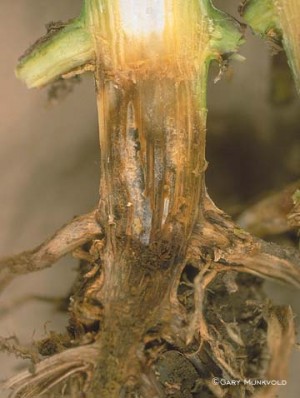
Fusarium rot in the crown
Gibberella Stalk Rot
Gibberella stalk rot over-winters in crop residue and soil. Infection occurs through roots, stalks, and leaves. Warm, wet conditions favor disease development. This disease causes pinkish-red discoloration inside the stalk. Another characteristic that can help identify Gibberella are small black specks on the stalk surface that can easily be scratched off. These specks are reproductive structures and can be used to distinguish Gibberella from Fusarium.
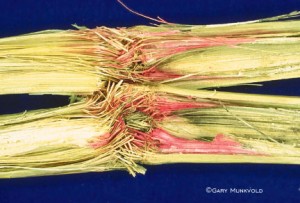
Pink discoloration of Gibberella
Anthracnose Stalk Rot
Anthracnose stalk rot is an aggressive pathogen that can be evident before plant death. High relative humidity, warm temperatures, and extended periods of cloudy weather favor disease development. Plants become infected soon after pollination, but symptoms aren’t immediately apparent. Symptoms of the stalk phase include shiny black lesions on the stalk’s outer rind that can’t be rubbed off with your fingernail. Internal stalk tissue, or pith, becomes discolored, turning gray to brown and shredded. Plants infected with Anthracnose can have top die back, giving the plants a dead appearance at the top of the plant and at the bottom of the plant with a green zone in the middle. The disease eventually causes the entire plant to die, with a later symptom being dead plants with tops bending over or breaking off.
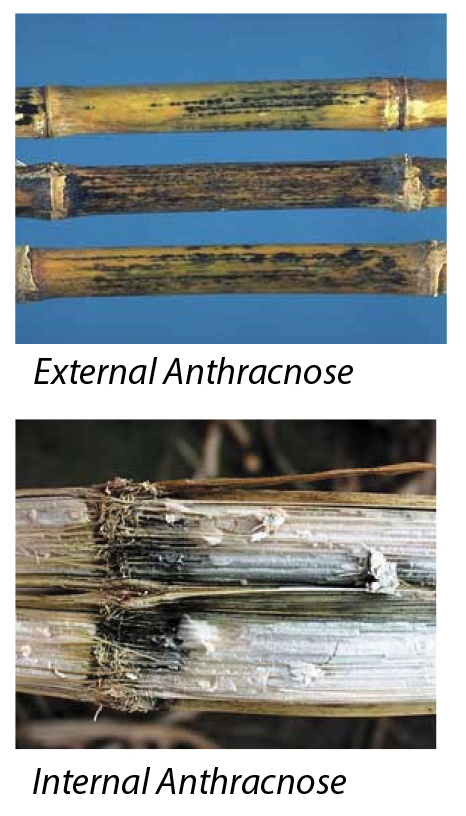
DIPLODIA Stalk Rot
Diplodia stalk rot can cause both stalk and ear rot diseases of corn. It over-winters in crop residue and infects the roots, crown, and lower stalk of corn. This disease can be identified by tiny dark brown/black reproductive structures called pycnidia, which are embedded in the rind of stalks. These structures feel rough like sandpaper and are not easily rubbed off.
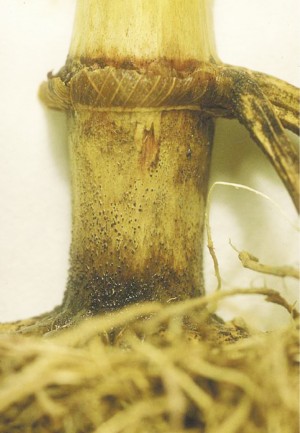
Pycnidia Diplodia on stalk rind
Physoderma Stalk Rot
Physoderma stalk rot is caused by the same same pathogen that causes Physoderma brown spot on leaves. Appearance of Physoderma on leaves isn’t necessarily indicative of stalk rot presence.
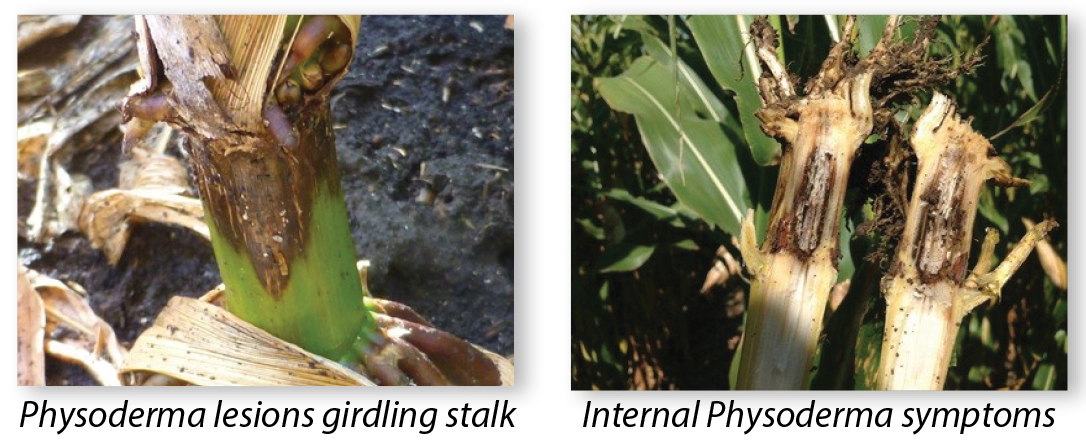
Physoderma infection occurs early in the season around V4 to V9 corn and requires free water, so wet June weather favors its development. Symptoms of the stalk rot phase include dark brown to black lesions encircling the stalk near the base which greatly weakens the stalk.
Conclusion
Inspect fields for stalk rots and overall stalk quality by scouting. Stalks can be split to look for stalk rots or the “pinch test” or “push test” can be used as corn nears maturity. If stalk quality is poor, harvest timing should be moved up to avoid severe losses due to lodging and harvest loss.
